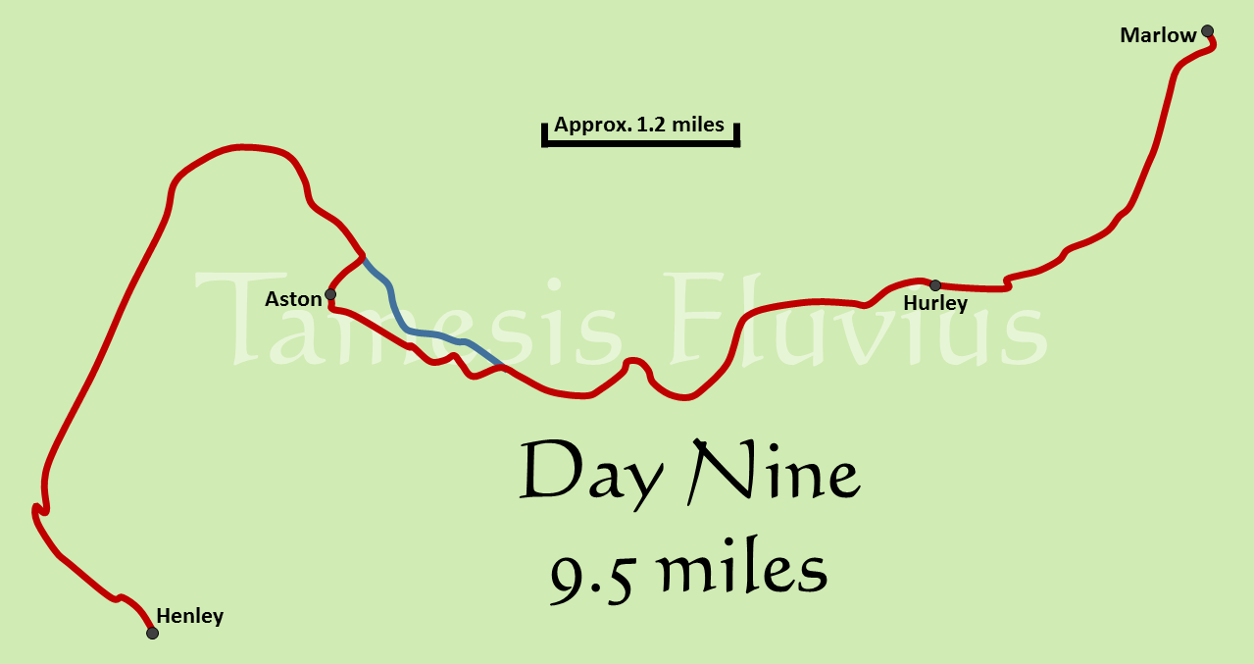Henley to Marlow
Sunday 16 April 2017

Although our Easter Sunday wasn't exactly a day of rest, it did turn out to be the shortest stage of the entire trip. The route from Henley to Marlow came in at nine and a half miles, not counting the additional walk to get back from our accommodation to the path itself, a fraction shorter than the distance between Oxford and Abingdon. It was also the busiest day so far, as many people were enjoying a day out along the river. Happily, the Thames was in view for almost the whole day, with even the one significant section away still largely keeping sight of it. The day also brought the first rain that we had encountered on the journey, although it turned out to be barely worthy of the description as a few spots were all that developed, with a much heavier shower holding off until late at night.
After a comfortable night at our Airbnb accommodation in a converted farmhouse, we headed out early to pick up the path again at the end of the walkway from Marsh Lock. The first part of the day's journey saw us passing by the impressive array of boats moored along the banks of the Thames, soon arriving in the centre of Henley where we briefly stepped away from the path to pick up some lunch from one of the few shops which was open for Easter Day. Returning to the path, we crossed over the river at Henley Bridge, heading back into Berkshire and turning to follow the opposite bank. This long, straight section of the river is the site of the annual Henley Regatta, with plenty of space alongside the path for the stands which are put up each year for spectators.
The rowing background of Henley was clearly shown by the many boathouses and numerous rowers out on the river, while the size of the yachts around them gave an idea of how affluent the area is. We soon passed by the mock ornamental temple at the southern end of Temple Island, which marks the starting point of the regatta races. Here, the river now marks the boundary between Berkshire and Buckinghamshire, but we would remain in Berkshire for most of the day and followed the Thames round to the right towards Hambledon Lock. The lock has another impressively long weir but this time we did not have to follow the walkway across it, staying on the southern bank and after a short rest, turning away from the river to the tiny hamlet of Aston.
After a short climb away from the Thames and into Aston, we turned towards the Culham Court estate. The path passes right through the estate, which has superb views back down the river as well as a deer park, which at first appeared to be empty but we did eventually see one group of deer just as we reached the far side of the park. Shortly after leaving the park, the path returns to the Thames and follows the bank closely, at one stage giving the option of a slightly overgrown route through the trees or a more open short cut as the river meanders around to the right. We soon emerged among the houses alongside Frogmill Farm, a lone picnic table providing us with the perfect opportunity to stop for lunch.
After passing between the houses and another impressive array of boats moored along the river bank, the path moves into the grounds of the Hurley Riverside Park, a large caravan site with plenty of adjoining open space alongside the Thames. The area around the park was full of people out boating on the river or enjoying picnics and ball games, even though despite the sunshine it was another cool afternoon in the breeze. Just before reaching the village of Hurley itself, we came to the large complex of islands which make up Hurley Lock. Here the Thames Path heads across a footbridge onto one of the islands and passes by the lock itself, before returning to the bank via another footbridge and heading on towards Marlow.
The final part of the day's route saw the path becoming ever more busy, as we were now sharing the route with those who were out for an afternoon walk from Marlow. Not long after Hurley Lock we reached Temple Footbridge, the longest wooden footbridge in Britain and a crossing only built in the late 1980s. It was built specifically for the Thames Path, to replace a long-discontinued ferry service and prevent a detour away from the river through Bisham. Heading over the bridge, we arrived in Buckinghamshire for the first time and having reached Temple Lock, took one final rest stop for the day before beginning the approach to Marlow.
It was slow progress at times on the way to Marlow as we had to negotiate our way through ever increasing crowds of people, some of them blocking most of the path by walking at what seemed to us like an unnaturally slow pace. Having passed by the Bisham Abbey National Sports Centre on the opposite bank, we were treated to a perfect view of Bisham's 12th century All Saints church. From there it was not long until Marlow Bridge came into view, which was where we were due to leave the Thames Path for the day. After a couple of days where there had been an additional journey at the end of the route, we were pleased that our accommodation for the night, a Premier Inn, was very close to the bridge meaning that we were able to relax much earlier than we had become used to.

























